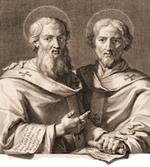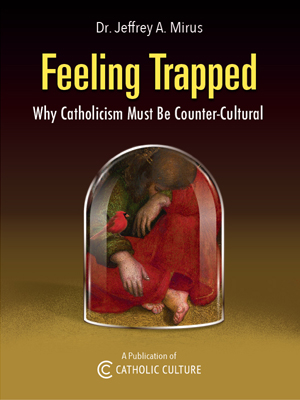Catechism of the Catholic Church
787 From the beginning, Jesus associated his disciples with his own life, revealed the mystery of the Kingdom to them, and gave them a share in his mission, joy, and sufferings. 215 Jesus spoke of a still more intimate communion between him and those who would follow him: "Abide in me, and I in you.... I am the vine, you are the branches." 216 And he proclaimed a mysterious and real communion between his own body and ours: "He who eats my flesh and drinks my blood abides in me, and I in him." 217
788 When his visible presence was taken from them, Jesus did not leave his disciples orphans. He promised to remain with them until the end of time; he sent them his Spirit. 218 As a result communion with Jesus has become, in a way, more intense: "By communicating his Spirit, Christ mystically constitutes as his body those brothers of his who are called together from every nation." 219
789 The comparison of the Church with the body casts light on the intimate bond between Christ and his Church. Not only is she gathered around him; she is united in him, in his body. Three aspects of the Church as the Body of Christ are to be more specifically noted: the unity of all her members with each other as a result of their union with Christ; Christ as head of the Body; and the Church as bride of Christ.
790 Believers who respond to God's word and become members of Christ's Body, become intimately united with him: "In that body the life of Christ is communicated to those who believe, and who, through the sacraments, are united in a hidden and real way to Christ in his Passion and glorification." 220 This is especially true of Baptism, which unites us to Christ's death and Resurrection, and the Eucharist, by which "really sharing in the body of the Lord, . . . we are taken up into communion with him and with one another." 221
791 The body's unity does not do away with the diversity of its members: "In the building up of Christ's Body there is engaged a diversity of members and functions. There is only one Spirit who, according to his own richness and the needs of the ministries, gives his different gifts for the welfare of the Church." 222 The unity of the Mystical Body produces and stimulates charity among the faithful: "From this it follows that if one member suffers anything, all the members suffer with him, and if one member is honored, all the members together rejoice." 223 Finally, the unity of the Mystical Body triumphs over all human divisions: "For as many of you as were baptized into Christ have put on Christ. There is neither Jew nor Greek, there is neither slave nor free, there is neither male nor female; for you are all one in Christ Jesus." 224
792 Christ "is the head of the body, the Church." 225 He is the principle of creation and redemption. Raised to the Father's glory, "in everything he [is] preeminent," 226 especially in the Church, through whom he extends his reign over all things.
793 Christ unites us with his Passover: all his members must strive to resemble him, "until Christ be formed" in them. 227 "For this reason we . . . are taken up into the mysteries of his life, . . . associated with his sufferings as the body with its head, suffering with him, that with him we may be glorified." 228
794 Christ provides for our growth: to make us grow toward him, our head, 229 he provides in his Body, the Church, the gifts and assistance by which we help one another along the way of salvation.
795 Christ and his Church thus together make up the "whole Christ" (Christus totus). The Church is one with Christ. The saints are acutely aware of this unity:
Let us rejoice then and give thanks that we have become not only Christians, but Christ himself. Do you understand and grasp, brethren, God's grace toward us? Marvel and rejoice: we have become Christ. For if he is the head, we are the members; he and we together are the whole man.... The fullness of Christ then is the head and the members. But what does "head and members" mean? Christ and the Church. 230Our redeemer has shown himself to be one person with the holy Church whom he has taken to himself. 231
Head and members form as it were one and the same mystical person. 232
A reply of St. Joan of Arc to her judges sums up the faith of the holy doctors and the good sense of the believer: "About Jesus Christ and the Church, I simply know they're just one thing, and we shouldn't complicate the matter." 233
796 The unity of Christ and the Church, head and members of one Body, also implies the distinction of the two within a personal relationship. This aspect is often expressed by the image of bridegroom and bride. The theme of Christ as Bridegroom of the Church was prepared for by the prophets and announced by John the Baptist. 234 The Lord referred to himself as the "bridegroom." 235 The Apostle speaks of the whole Church and of each of the faithful, members of his Body, as a bride "betrothed" to Christ the Lord so as to become but one spirit with him. 236 The Church is the spotless bride of the spotless Lamb. 237 "Christ loved the Church and gave himself up for her, that he might sanctify her." 238 He has joined her with himself in an everlasting covenant and never stops caring for her as for his own body: 239
This is the whole Christ, head and body, one formed from many . . . whether the head or members speak, it is Christ who speaks. He speaks in his role as the head (ex persona capitis) and in his role as body (ex persona corporis). What does this mean? "The two will become one flesh. This is a great mystery, and I am applying it to Christ and the Church." 240 And the Lord himself says in the Gospel: "So they are no longer two, but one flesh." 241 They are, in fact, two different persons, yet they are one in the conjugal union, . . . as head, he calls himself the bridegroom, as body, he calls himself "bride." 242
Notes:
English Translation of the Cathechism of the Catholic Church for the United States of America © 1997, United States Catholic Conference, Inc.






